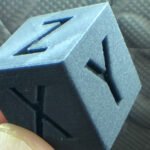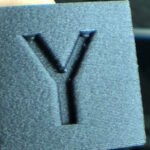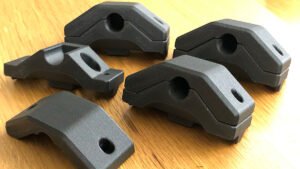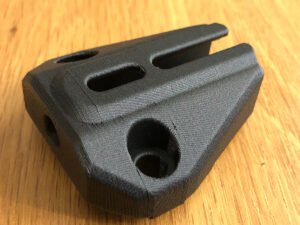Table of Contents
Oh, my god! That’s my reaction every time I pull a print off the bed using this Carbon Fibre PETG filament from 3DFilaPrint. The finish is unique and has a breath-taking sheen. I’m in love with this stuff.
So five stars then? Amazing? So, the review is done? Well, not quite. There’s a still lot more to say and show.

3DFilaPrint Carbon Fibre PETG Specification
- Material – PETG filament infused with 20% Carbon Fibre
- Colour – A dark matte grey
- Diameter – 1.75mm
- Filament weight – 500g
- Print temperature – 225-245°C
- Bed temperature – They claim it does not require a heated bed, but if available heat between 35-60°C (we’ll see about that… read on)
3D Printing with 3DFilaPrint Carbon Fibre PETG
Carbon Fibre first 3D print
The filament is Carbon Fibre PETG from 3DFilaPrint in the UK. It’s sold as easy to print, and with no warp on a low temperature bed. It can supposedly even print without a heated bed if you use a glue stick or another type of adhesive. Well, I guess this depends on the bed, as I kicked it off at 60°C on a textured 3D printer bed surface using the generic PETG profile in my slicer. And immediately I got this result.

Yikes! Poor adhesion and some terrible layer lines on the side. I had started with a generic PETG profile and altered the bed temperature to something lower, as suggested. What a mess!
Time to calibrate
So maybe not super easy to print with this, which for me would mean loading the filament and hitting ‘go’. I think we can all agree 3DFilaPrint Carbon Fibre PETG needs some calibration. The layer lines looked under extruded, so I started with that and did some test prints with different extrusion multipliers and found 1.1 (110%) to work nicely.
However, it would just not stick to the bed. So being a PETG based filament, I just turned up the bed temperature, and that seemed to get me almost there. The last thing I needed to do was slow down the first layer to 20mm/s.
And then it was time for a test. So a 20mm calibration cube. And wow! It stunned me. From that first horrible print to this. Just look at the sheen.
The XYZ cube has beautiful layer lines. They just stack on top of each other with such precision. On looking at the right edge of the inset Y and you cannot see ghosting. The surface finish is matte dark grey, but when it catches the light just right it gets a lovely sheen. So this is what Carbon Fibre PETG looks like!
Real world Carbon Fibre prints
Next I did a few functional 3D prints. I am building a Zaribo 3D Printer in the near future. But I wanted to customise the 3D printer by using my own printed parts. And nothing screams mechanical than carbon fibre. So how about I print some parts to build a 3D printer – why not?
These are some of the best prints I’ve had. There were still some issues with bridging though. While it is a PETG, I found it needed some extra cooling. On bridges I had to jump cooling up to 100%, and also reduce the bridge flow to 65%.
None of the parts warped. In fact, the x-axis motor holder (below right) has been a nightmare to print with PETG (4 perimeters and 35% infill, so very solid). And it just warped every time I tried it. However, with the high carbon fibre content in this PETG it never, ever showed any sign of warping.
The one area this 3DFilaPrint Carbon Fibre PETG struggles is supports. Every time I used supports I ended up with some spaghetti. Slowing support speed helped a lot and gets you most of the way there. But if the support needs to build on top of a printed surface, then it had trouble adhering.
What’s the enormous deal about Carbon Fibre?
Well, apart from the lovely sheen, that it didn’t warp? Adding composite fibres to a filament is also a way to improve specific properties. Carbon Fibre has an impressive strength to weight ratio, so they commonly add it to PLA or PETG for strength. I can attest to this as I had a few of the warped x-axis motor parts printed in standard PETG from eSun and Sunlu. And these I can press and deform easily. Even hearing some cracking as the infill gives inside them. But the carbon printed part is tough. Real tough! And it gives nothing like the standard PETG filament. You can find out about other carbon fibre filaments here.
3DFilaPrint Carbon Fibre PETG Conclusion
This 3DFilaPrint Carbon Fibre PETG is not cheap. With VAT is is around £35 per 500g. But the results are just so damned beautiful with an amazing sheen. The pictures just don’t do it justice. Supports may be difficult, but for functional parts at least, you can usually work around those. I got a clog at one point, which was annoying (isn’t it always?), but cleared that and got back to printing.
Where to buy?
3DFilaPrint Carbon Fibre PETG is available directly from their website. They sell many other filaments and you can also learn more from their twitter.
Want to know how to improve your PETG prints, then will read our PETG 3D Printer Filament Tips, Tricks and Uses!
More Articles












